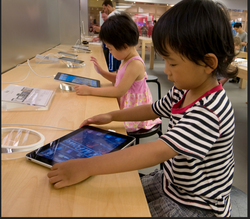
This week we were introduced to sites like diigo, wolframalpha, instagrok and spezify and I cannot help but think how much the way we access information has changed since I was a student. When I was in high school in the 1990s computers and the internet were gaining in popularity but they were not a regular part of our lives. In fact I remember spending hours at the school library and the public library looking up keywords in the card catalogue and trying to find books or magazines with the "right" information I needed to write my term paper. Then I had to take notes on my index cards and hope I copied the citation and information correctly. It was time consuming and hard to fit in trips to the library with all my extracurricular activities. Now students can access the whole world anytime on their computers, phones or tablets! This really is amazing.
What does this mean for those of us who are aspiring educators or are currently classroom teachers? I think it means that we must know how to most effectively use the technology to teach our students how to find information and then use this information. If we can show our students sites like wolframalpha and instagrok then we can begin to show them how to effectively find the information they need to know. We must teach them how to use the tools because once they can use the these tools well then the entire world is open to them. They will be able to find information quickly and then in turn spend more time analyzing, elaborating and extrapolating what they are learning or in other words engaging in high order thinking. They will not be caught up as I was in the tedious search process and then scrambling to regurgitate what they read. Instead they will be able to truly learn and take in the information. Of course we must teach them to do this. It is not enough to give them search engines or even the "how to" of searching. We must show them how to organize, analyze and elaborate on what they learn. This is where diigo comes into the picture. As the teacher we can have a classroom diigo site where we have saved searches, highlighted the important information the students must read and use and even have sticky notes written with our thoughts for the students to read at the site. This site even allows you to tag a site in any category you wish to give it. And you know what this means right? No more index cards with a bunch of facts written down that are easy to loose or get out of order!!!!
So here is how this can work, if the students are studying the surrealist movement the information can be tagged as surrealism and art and literature and saved to their diigo so that both subcategories of the movement are represented and easily found. Finally, here comes when the students move into higher order or metacognitive thinking about the information. This can be achieved by having the students write blogs (which is what my professor is doing for this class) about what they read. Writing a blog is certainly less stressful than having to write a paper but it can be just as enriching an experience. Students today view blogs as a place to not only document their life but a place to spout off and give their own thoughts and views on the world around them and what they are learning. How awesome would it be to have a class of 11th graders blogging about surrealism in Gabriel García Márquez's books or in Salvador Dalí's paintings. Sure some of what surrealists did may appear weird to students but in a blog form they will be more likely to express that but within the context of interacting and thinking about the information in the format you as a teacher requires and of course engaging in the ever important skill of metacognitive thinking.
I think using technology this way will instantly take some of the stigma out of research and traditional paper writing for our students because it will all be in a format that is easier to use than we have had in the past and let's face it technology is more fun!
What does this mean for those of us who are aspiring educators or are currently classroom teachers? I think it means that we must know how to most effectively use the technology to teach our students how to find information and then use this information. If we can show our students sites like wolframalpha and instagrok then we can begin to show them how to effectively find the information they need to know. We must teach them how to use the tools because once they can use the these tools well then the entire world is open to them. They will be able to find information quickly and then in turn spend more time analyzing, elaborating and extrapolating what they are learning or in other words engaging in high order thinking. They will not be caught up as I was in the tedious search process and then scrambling to regurgitate what they read. Instead they will be able to truly learn and take in the information. Of course we must teach them to do this. It is not enough to give them search engines or even the "how to" of searching. We must show them how to organize, analyze and elaborate on what they learn. This is where diigo comes into the picture. As the teacher we can have a classroom diigo site where we have saved searches, highlighted the important information the students must read and use and even have sticky notes written with our thoughts for the students to read at the site. This site even allows you to tag a site in any category you wish to give it. And you know what this means right? No more index cards with a bunch of facts written down that are easy to loose or get out of order!!!!
So here is how this can work, if the students are studying the surrealist movement the information can be tagged as surrealism and art and literature and saved to their diigo so that both subcategories of the movement are represented and easily found. Finally, here comes when the students move into higher order or metacognitive thinking about the information. This can be achieved by having the students write blogs (which is what my professor is doing for this class) about what they read. Writing a blog is certainly less stressful than having to write a paper but it can be just as enriching an experience. Students today view blogs as a place to not only document their life but a place to spout off and give their own thoughts and views on the world around them and what they are learning. How awesome would it be to have a class of 11th graders blogging about surrealism in Gabriel García Márquez's books or in Salvador Dalí's paintings. Sure some of what surrealists did may appear weird to students but in a blog form they will be more likely to express that but within the context of interacting and thinking about the information in the format you as a teacher requires and of course engaging in the ever important skill of metacognitive thinking.
I think using technology this way will instantly take some of the stigma out of research and traditional paper writing for our students because it will all be in a format that is easier to use than we have had in the past and let's face it technology is more fun!

 RSS Feed
RSS Feed